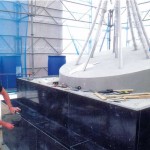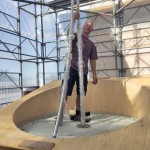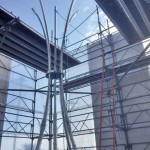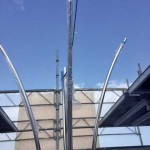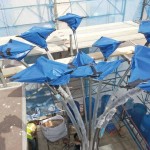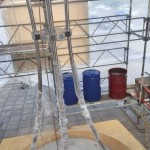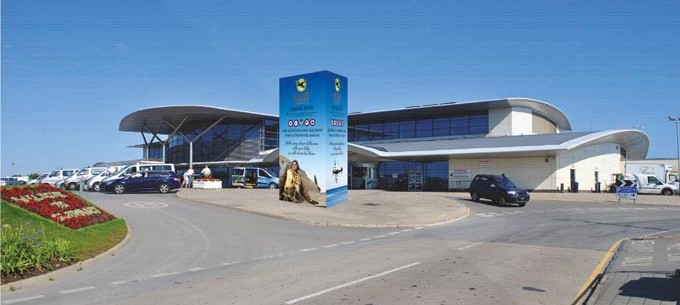The Build
Having agreed upon an appropriate design, the Committee had to give their attention to three pressing issues. One was raising sufficient funds to support building costs that had been estimated to be more than £100,000. The second was the time-frame in which the completed memorial would be delivered and finally, obtaining planning permission for the preferred design. The Committee had unanimously agreed that the most appropriate date for completion would be during Battle of Britain Week 2015, the year in which we would celebrate the 70th Anniversary of Liberation from Occupying Forces. It was also agreed that we should hold an event at which we would formally launch our appeal for funding and unveil to the public our design for the memorial.
At the next committee meeting, John Goodwin and Richard Heaume were invited to attend so that we could concentrate on the historical aspect of the memorial. Because the details were going to be, literally, set in stone we had to ensure that all information was correct. It was decided that the Committee should establish contact with representatives of the countries from which the aircrews came to compare the information held by them with that compiled over many years by John Goodwin. As we received answers to our queries, it became obvious that we did not hold complete information. To date, the original figure of 110 airmen has increased to 153 but could be even more as research will continue after the Memorial is dedicated. Names will be added as necessary. Our agreed aim was to ensure that no-one would be forgotten.
Fund raising continued with letters to individuals, organisations, parishes, islands of the Bailiwick and the general public. John Goodwin and Committee Member Simon Hamon gave evening talks at local meetings. Friends and contacts of Committee members were given a gentle ‘sell’ message…and gradually donations large and small kept encouraging the Committee that the target would be met. Committee Member Mike Snelling kept the media informed of progress and they gave us good publicity. In order to maintain the momentum, keep the public informed of our progress and remind everyone of the reason for the Memorial, Paul Staples proposed to the Committee that a very large display box be positioned on the site of the eventual Memorial. It was to be mounted on the second concrete base level and one side was dedicated to naming those local companies, organisations and individuals who had supported the scheme. The other three sides explained the project.
This initiative was very closely followed by the electronic Book of Remembrance.
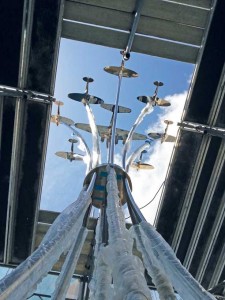
Metamorphosis – The first test flight!
Only the ranks and names of the 153 individuals could be placed on the plaques on the Memorial. John Goodwin and Simon Hamon had compiled a great deal more background information about many of the individuals and the incidents in which they died. The Committee felt that this information should be recorded, not only for general public interest, but also for access by the relatives of the deceased, many living overseas and who may never be able to visit Guernsey. Surfing the internet, and amazingly for a computer dinosaur, Evan Ozanne came upon an electronic Book of Remembrance at the Edinburgh Crematorium. From his home computer, he could turn the pages of this Book of Remembrance. Ideal for our need to expand on the information we had on each individual and also to allow relatives to search our Book on the world-wide web. Again using the internet, contact was made with a Company in the UK who manufactured a console that could be connected to the Guernsey airport web site. Simon Hamon took up the challenge of liaising with the supplying Company, resolving the design of the web site and providing pages of information on each of the 153 individuals and where possible supporting pages giving details of the individual ditching incidents.
The original plan had been to dismantle the Tardis on the 1st July 2015 so that building of the Memorial could commence. However, after a meeting with the principal contractors, Pat Johnson informed the AAM Committee that it had been decided to enlarge the parameters of the Tardis surrounding the concrete bases so work could start and continue behind Tardis panels mounted on scaffolding. On the evening prior to the Dedication Ceremony, the Tardis and scaffolding would be removed and reveal The Memorial in all its glory.
His argument was that the flagpoles would have to be erected and moved every time there was a parade whereas the six trees would be green, living ‘flag poles’- each one representing a different country for the deceased. These trees are now in situ and growing happily. They also enhance the approach to the Terminal building.
The project had started with a bed in March 2013 and today, the 9th September 2015, the Allied Aircrew Committee can happily put the Memorial ‘to bed’.
Behind the scaffolding and remnants of the Tardis display boards a chrysalis was shedding into a shiny, stainless steel, beautiful sculpture pointing upwards to the skies in which the aircrews had flown and lost their lives.
